This article was co-authored by wikiHow staff writer, Jennifer Mueller, JD. Jennifer Mueller is a wikiHow Content Creator. She specializes in reviewing, fact-checking, and evaluating wikiHow's content to ensure thoroughness and accuracy. Jennifer holds a JD from Indiana University Maurer School of Law in 2006.
There are 8 references cited in this article, which can be found at the bottom of the page.
This article has been viewed 92,694 times.
Learn more...
Postal addressing in Spanish-speaking countries is different from the addressing systems in the US and other English-speaking countries. Spain has different conventions than Latin American countries. Some Latin American countries don't use a post code system. Additionally, houses are located by their proximity to landmarks, rather than a specific street address. However, the basic elements of a Latin American address are similar.[1]
Steps
Spain
-
1Place the address in the center-right of the envelope. Your placement of the address on the envelope ensures it won't be obscured by postal service markings or stamps. Start the address 4 or 5 lines from the top, to leave space for stamps and postal service markings.
- If you're typing your envelope, you may want to set your left margin at the mid-line of the envelope.
-
2Use the 12- or 15-point font and single line spacing. Any commercially available font is acceptable. Do not type in bold or italics, or underline any part of the address.
- If you're writing the address by hand, write in print. None of the characters should overlap or touch each other. Keep the characters between 2 and 8 millimetres (0.079 and 0.315 in).
Advertisement -
3Type the name of the recipient on the first line. Include the full name of the recipient to ensure proper delivery. Titles or honorifics (such as señor) can be abbreviated. If you are including both an individual's name and a business name, put them both on the same line.[2]
- Example: Sr. D. Jaime Lozano Seguí
Common Abbreviations for Titles and Honorifics
Sr – señor
Sra – señora
Srta – señorita
D. – don
Dª, Dña – doña
Dr. – doctor
Dra. – doctora
Prof. – profesor
Profa. – profesora -
4Provide information about the street and location. Spanish addresses include the street address, floor, and door number. Write the street and house or building number first, followed by a comma. For some addresses, you will also include the stairwell number after the abbreviation "Esc." Put a comma after the stairwell number. Add the floor number with a º symbol, then another comma. Finally, type the door number or letter.[3]
- Example: Plaza de las Descalzas 27, Esc 2, 3º, C.
-
5List the post code, locality, province, and country on the remaining lines. Under the street address, type the 5-digit postal code. Type a space after the postal code, then the name of the locality in all capital letters. On the next line, type the name of the province, also in all-caps. Type "SPAIN" on the last line of the address.[4]
- Example: 45012 TOLEDO / TOLEDO / SPAIN
Spain Mailing Address
Addressee First Name Last Name
Street Name #, Esc. #, #º, Door.
Postal code LOCALITY
PROVINCE
SPAIN
Latin America
-
1Place the address on the right-hand side of the envelope. Most Latin American countries use the lower-right portion of the envelope for the mailing address. If you're typing the address, left-align your text from the mid-line of the envelope. Start 5 or 6 lines down to leave enough room for stamps and postal markings.[5]
- If typing set your line spacing to single space. If you're writing the address by hand, try to keep your lines straight and make sure they don't overlap each other.
- Some countries are the exception to this rule. For example, if you're mailing something to Colombia, place the address in the middle of the envelope, and center the lines rather than left-aligning them.
-
2Print neatly or use a legible font. Not all Latin American countries have specific requirements for font or font size. Choose a clean, legible font in a 12- or 15-point size, if you're typing. If you're writing the address by hand, print neatly.[6]
- Some countries have specific requirements. For example, Argentina Post prefers addresses to be typed in 12- or 15-point Courier or Helvetica. Argentina Post also specifies typing in all caps, with no accent marks.
-
3Provide the recipient's name on the first line. Include the recipient's first and last name for more accurate delivery. If you use an abbreviation for a title or honorific (such as "Sra" for "señora"), you typically don't need a period at the end of the abbreviation.[7]
- Example: Sra Otilia Ramos Perez
- If you are sending a letter to a business or government department in Colombia, write out the full name without abbreviations.
-
4Identify the street address and premises on the second line. Typically, you'll type the name of the street, followed by the street number for the specific house or building. For rural addresses, you may have a sub-locality or description of landmarks.
- Argentina Post specifies to use the word calle if the address is a numbered street. If the street name ends in a number, use the abbreviation "No" before the street number. For example: CALLE 42 No 1340.[8]
- A rural address in Argentina would include the name of the farm or rural school on this line, rather than a street name and number.
-
5Include additional information on the third line if necessary. Some Latin American addresses require a third line for proper delivery. Information from the second line also may spill over onto the third, such as if you had a long street name or building name.[9]
- For example, addresses in Mexico identify the recipient's colonia (neighborhood) on the third line. The word colonia is typically abbreviated "Col." Capitalize the first letter and put a period at the end of the abbreviation.
- Some urban addresses in Colombia may include the sub-locality (similar to a Mexican colonia) on the third line.[10]
-
6List the postal code and locality after the street address. This line is typically known as the "city line." For most Latin American addresses that have postal codes, the postal code is listed first, followed by the name of the locality. Type the name of the locality in all caps.
- For Mexican addresses include the abbreviation for the province after the locality. For example: 02860 MEXICO, CDMX
- For Colombian addresses, the locality comes first, followed by the 6-digit postal code.[11]
-
7Close with the name of the country. The final line of your address is the name of the country in all caps. For the purposes of mailing from the US or other English-speaking countries, it is acceptable to write the name of the country in English.
- For example, if you're mailing a letter to an address in México, you could simply write "MEXICO" on the country line, although you could also use the Spanish spelling, with the accent over the e.
- There's no need to put "SOUTH AMERICA" or "CENTRAL AMERICA" below the country name.
Latin America Mailing Address
Urban:
Addressee First Name Last Name
Street Name # floor/door/dept.
Sub-locality, Colonia [México]
Postal Code LOCALITY
COUNTRYRural:
Addressee First Name Last Name
Sub-Locality / Landmarks / Farm Name
Postal Code LOCALITY
COUNTRY
Community Q&A
-
QuestionHow are addresses written in Mexico?
 Drew Hawkins1Community AnswerIn Mexico, and Latin America in general, addresses are written in a specific way. Most Latin American countries use the lower-right portion of the envelope for the mailing address. The first line features the recipient's first and last name. Then, add the street address and the premises on the second line. Usually, it'll be the name of the street followed by the street number for the specific house or building. But for rural addresses, you may have a sub-locality of description of landmarks. For instance, you may include the name of the farm or rural school rather than the street name and number. Finally, list the postal code and the locality, including the city, territory, and country. Type the locality in all caps. That's it!
Drew Hawkins1Community AnswerIn Mexico, and Latin America in general, addresses are written in a specific way. Most Latin American countries use the lower-right portion of the envelope for the mailing address. The first line features the recipient's first and last name. Then, add the street address and the premises on the second line. Usually, it'll be the name of the street followed by the street number for the specific house or building. But for rural addresses, you may have a sub-locality of description of landmarks. For instance, you may include the name of the farm or rural school rather than the street name and number. Finally, list the postal code and the locality, including the city, territory, and country. Type the locality in all caps. That's it! -
QuestionDoes Mexico have zip code?
 Drew Hawkins1Community AnswerYes! In Mexico, a zip code or postal code is actually called a código postal (C.P.). They function essentially the same as zip codes in the US. They're made up of 5 digits and appear on the last line of an address. However, there are a few minor differences in how they're written. The CP is written on the last line of the address, just like it is in the US and many countries. But for most Latin American addresses that have postal codes, the postal code is listed first, followed by the name of the locality. So for example, a Mexican address could look like "02860, MEXICO, CDMX."
Drew Hawkins1Community AnswerYes! In Mexico, a zip code or postal code is actually called a código postal (C.P.). They function essentially the same as zip codes in the US. They're made up of 5 digits and appear on the last line of an address. However, there are a few minor differences in how they're written. The CP is written on the last line of the address, just like it is in the US and many countries. But for most Latin American addresses that have postal codes, the postal code is listed first, followed by the name of the locality. So for example, a Mexican address could look like "02860, MEXICO, CDMX." -
QuestionHow do you write an address in Spain?
 Drew Hawkins1Community AnswerOn the outside of the envelope, place the address in the center-right portion of the front. That way, it won't be obscured by postal markings and stamps. Be sure to include the full name of the recipient so it gets delivered to the right person. Then, add the street and location info. Spanish addresses include the street address, floor, and door number. Write the street and house or building number first, followed by a comma. If the address has a stairwell number, include abbreviation "Esc" in front of the number. On the third line, put the 5-digit postal code and the locality in all caps. On the fourth line, add the name of the province in all caps, and then type "SPAIN" underneath it to complete your Spanish address!
Drew Hawkins1Community AnswerOn the outside of the envelope, place the address in the center-right portion of the front. That way, it won't be obscured by postal markings and stamps. Be sure to include the full name of the recipient so it gets delivered to the right person. Then, add the street and location info. Spanish addresses include the street address, floor, and door number. Write the street and house or building number first, followed by a comma. If the address has a stairwell number, include abbreviation "Esc" in front of the number. On the third line, put the 5-digit postal code and the locality in all caps. On the fourth line, add the name of the province in all caps, and then type "SPAIN" underneath it to complete your Spanish address!
References
- ↑ https://www.spanishdict.com/guide/how-to-write-an-address-in-spanish
- ↑ https://www.lawlessspanish.com/vocabulary/titles/
- ↑ https://www.spanish.academy/blog/how-to-write-your-address-in-spanish/
- ↑ https://www.spanish.academy/blog/how-to-write-your-address-in-spanish/
- ↑ https://www.spanish.academy/blog/how-to-write-your-address-in-spanish/
- ↑ https://www.washburn.edu/faculty-staff/umaps/how%20to%20mail%20US%20and%20International.pdf
- ↑ https://www.upu.int/UPU/media/upu/PostalEntitiesFiles/addressingUnit/mexEn.pdf
- ↑ https://www.upu.int/UPU/media/upu/PostalEntitiesFiles/addressingUnit/argEn.pdf
- ↑ https://www.spanishdict.com/guide/how-to-write-an-address-in-spanish
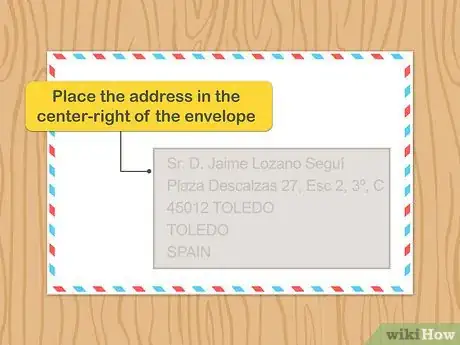

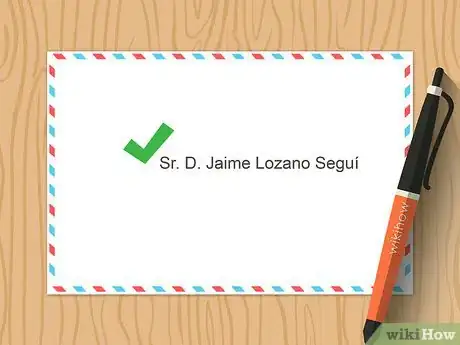
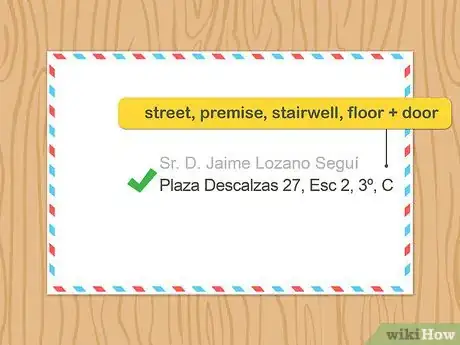
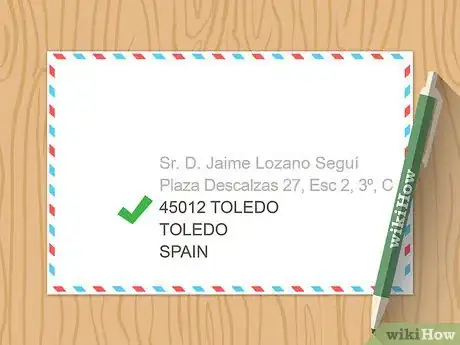
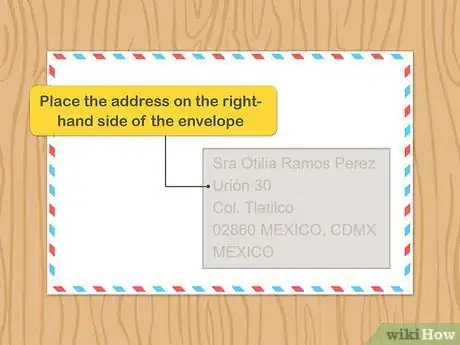
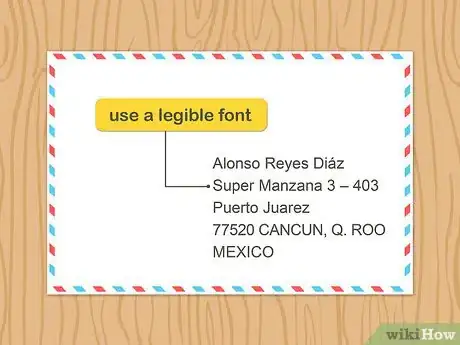
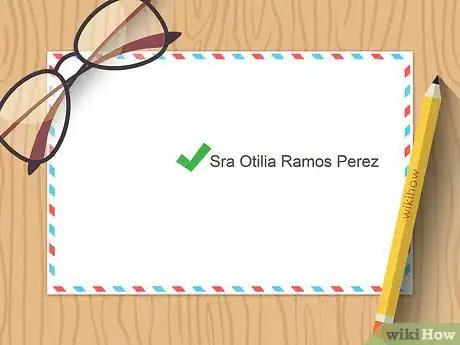

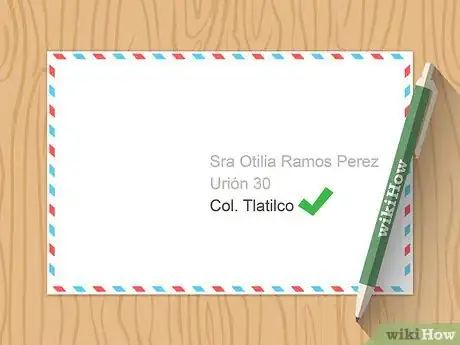
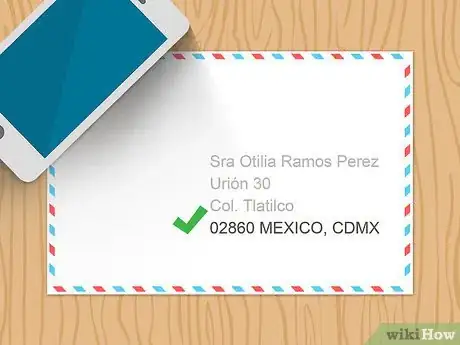
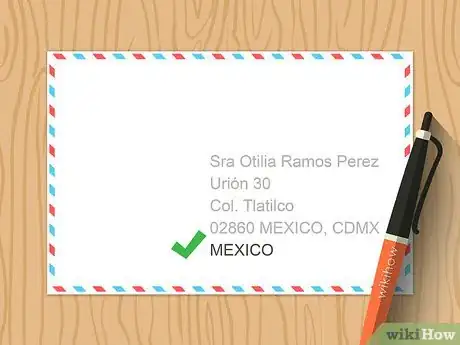







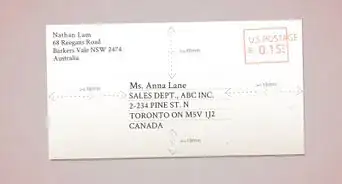

-Step-18-Version-3.webp)

















































